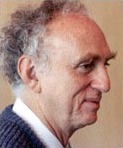
In nuclear physics, beta decay (β-decay) is a type of radioactive decay in which an atomic nucleus emits a beta particle, transforming into an isobar of that nuclide. For example, beta decay of a neutron transforms it into a proton by the emission of an electron accompanied by an antineutrino; or, conversely a proton is converted into a neutron by the emission of a positron with a neutrino in so-called positron emission. Neither the beta particle nor its associated (anti-)neutrino exist within the nucleus prior to beta decay, but are created in the decay process. By this process, unstable atoms obtain a more stable ratio of protons to neutrons. The probability of a nuclide decaying due to beta and other forms of decay is determined by its nuclear binding energy. The binding energies of all existing nuclides form what is called the nuclear band or valley of stability. For either electron or positron emission to be energetically possible, the energy release or Q value must be positive.

A muon is an elementary particle similar to the electron, with an electric charge of −1 e and a spin of 1/2, but with a much greater mass. It is classified as a lepton. As with other leptons, the muon is not thought to be composed of any simpler particles.

The Standard Model of particle physics is the theory describing three of the four known fundamental forces in the universe and classifying all known elementary particles. It was developed in stages throughout the latter half of the 20th century, through the work of many scientists worldwide, with the current formulation being finalized in the mid-1970s upon experimental confirmation of the existence of quarks. Since then, proof of the top quark (1995), the tau neutrino (2000), and the Higgs boson (2012) have added further credence to the Standard Model. In addition, the Standard Model has predicted various properties of weak neutral currents and the W and Z bosons with great accuracy.

In particle physics, a lepton is an elementary particle of half-integer spin that does not undergo strong interactions. Two main classes of leptons exist: charged leptons, including the electron, muon, and tauon, and neutral leptons, better known as neutrinos. Charged leptons can combine with other particles to form various composite particles such as atoms and positronium, while neutrinos rarely interact with anything, and are consequently rarely observed. The best known of all leptons is the electron.

The tau, also called the tau lepton, tau particle, tauon or tau electron, is an elementary particle similar to the electron, with negative electric charge and a spin of 1/2. Like the electron, the muon, and the three neutrinos, the tau is a lepton, and like all elementary particles with half-integer spin, the tau has a corresponding antiparticle of opposite charge but equal mass and spin. In the tau's case, this is the "antitau". Tau particles are denoted by the symbol
τ−
and the antitaus by
τ+
.
In particle physics, the baryon number is a strictly conserved additive quantum number of a system. It is defined as
In particle physics, the W and Z bosons are vector bosons that are together known as the weak bosons or more generally as the intermediate vector bosons. These elementary particles mediate the weak interaction; the respective symbols are
W+
,
W−
, and
Z0
. The
W±
bosons have either a positive or negative electric charge of 1 elementary charge and are each other's antiparticles. The
Z0
boson is electrically neutral and is its own antiparticle. The three particles each have a spin of 1. The
W±
bosons have a magnetic moment, but the
Z0
has none. All three of these particles are very short-lived, with a half-life of about 3×10−25 s. Their experimental discovery was pivotal in establishing what is now called the Standard Model of particle physics.

The LHCb experiment is a particle physics detector experiment collecting data at the Large Hadron Collider at CERN. LHCb is a specialized b-physics experiment, designed primarily to measure the parameters of CP violation in the interactions of b-hadrons. Such studies can help to explain the matter-antimatter asymmetry of the Universe. The detector is also able to perform measurements of production cross sections, exotic hadron spectroscopy, charm physics and electroweak physics in the forward region. The LHCb collaborators, who built, operate and analyse data from the experiment, are composed of approximately 1650 people from 98 scientific institutes, representing 22 countries. Vincenzo Vagnoni succeeded on July 1, 2023 as spokesperson for the collaboration from Chris Parkes. The experiment is located at point 8 on the LHC tunnel close to Ferney-Voltaire, France just over the border from Geneva. The (small) MoEDAL experiment shares the same cavern.

Neutrino oscillation is a quantum mechanical phenomenon in which a neutrino created with a specific lepton family number can later be measured to have a different lepton family number. The probability of measuring a particular flavor for a neutrino varies between three known states, as it propagates through space.
In particle physics, weak isospin is a quantum number relating to the electrically charged part of the weak interaction: Particles with half-integer weak isospin can interact with the
W±
bosons; particles with zero weak isospin do not. Weak isospin is a construct parallel to the idea of isospin under the strong interaction. Weak isospin is usually given the symbol T or I, with the third component written as T3 or I3.T3 is more important than T; typically "weak isospin" is used as short form of the proper term "3rd component of weak isospin". It can be understood as the eigenvalue of a charge operator.

Martin Lewis Perl was an American chemical engineer and physicist who won the Nobel Prize in Physics in 1995 for his discovery of the tau lepton.
In particle physics, flavour or flavor refers to the species of an elementary particle. The Standard Model counts six flavours of quarks and six flavours of leptons. They are conventionally parameterized with flavour quantum numbers that are assigned to all subatomic particles. They can also be described by some of the family symmetries proposed for the quark-lepton generations.

Neutrinoless double beta decay (0νββ) is a commonly proposed and experimentally pursued theoretical radioactive decay process that would prove a Majorana nature of the neutrino particle. To this day, it has not been found.

This article describes the mathematics of the Standard Model of particle physics, a gauge quantum field theory containing the internal symmetries of the unitary product group SU(3) × SU(2) × U(1). The theory is commonly viewed as describing the fundamental set of particles – the leptons, quarks, gauge bosons and the Higgs boson.
In quantum electrodynamics, the anomalous magnetic moment of a particle is a contribution of effects of quantum mechanics, expressed by Feynman diagrams with loops, to the magnetic moment of that particle. The magnetic moment, also called magnetic dipole moment, is a measure of the strength of a magnetic source.

The Michel parameters, usually denoted by and , are four parameters used in describing the phase space distribution of leptonic decays of charged leptons, . They are named after the physicist Louis Michel. Sometimes instead of , the product is quoted. Within the Standard Model of electroweak interactions, these parameters are expected to be
In particle physics, the Pontecorvo–Maki–Nakagawa–Sakata matrix, Maki–Nakagawa–Sakata matrix, lepton mixing matrix, or neutrino mixing matrix is a unitary mixing matrix which contains information on the mismatch of quantum states of neutrinos when they propagate freely and when they take part in weak interactions. It is a model of neutrino oscillation. This matrix was introduced in 1962 by Ziro Maki, Masami Nakagawa, and Shoichi Sakata, to explain the neutrino oscillations predicted by Bruno Pontecorvo.
The diffuse supernova neutrino background(DSNB) is a theoretical population of neutrinos (and anti-neutrinos) cumulatively originating from all core-collapse supernovae events throughout the history of the universe. Though it has not yet been directly detected, the DSNB is theorized to be isotropic and consists of neutrinos with typical energies on the scale of 107 eV. Current detection efforts are limited by the influence of background noise in the search for DSNB neutrinos and are therefore limited to placing limits on the parameters of the DSNB, namely the neutrino flux. Restrictions on these parameters have gotten more strict in recent years, but many researchers are looking to make direct observations in the near future with next generation detectors. The DSNB is not to be confused with the cosmic neutrino background (CNB), which is comprised by relic neutrinos that were produced during the Big Bang and have much lower energies (10−4 to 10−6 eV).
The Enhanced NeUtrino BEams from kaon Tagging or ENUBET is an ERC funded project that aims at producing an artificial neutrino beam in which the flavor, flux and energy of the produced neutrinos are known with unprecedented precision.
Monitored neutrino beams are facilities for the production of neutrinos with unprecedented control of the flux of particles created inside and outside the facility.





















